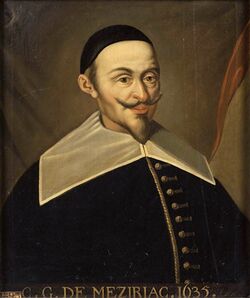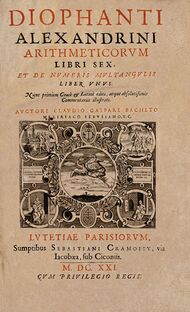Biography:Claude Gaspard Bachet de Méziriac
Claude Gaspard Bachet de Méziriac (9 October 1581 – 26 February 1638) was a French mathematician, linguist, poet and classics scholar born in Bourg-en-Bresse, at that time belonging to Duchy of Savoy.
Bachet was a pupil of the Jesuit mathematician Jacques de Billy at the Jesuit College in Rheims. They became close friends.
Bachet wrote the Problèmes plaisants, of which the first edition was issued in 1612, a second and enlarged edition was brought out in 1624; this contains an interesting collection of arithmetical tricks and questions, many of which are quoted in W. W. Rouse Ball's Mathematical Recreations and Essays. He also wrote Les éléments arithmétiques, which exists in manuscript; and a translation, from Greek to Latin, of the Arithmetica of Diophantus (1621). It was this very translation in which Fermat wrote his famous margin note claiming that he had a proof of Fermat's last theorem. The same text renders Diophantus' term παρισὀτης as adaequalitat, which became Fermat's technique of adequality, a pioneering method of infinitesimal calculus.
Bachet was the earliest writer who discussed the solution of indeterminate equations by means of continued fractions. He also did work in number theory and found a method of constructing magic squares. Some credible sources[who?] also name him the founder of the Bézout's identity.[1]
For a year in 1601 Bachet was a member of the Jesuit Order. He lived a comfortable life in Bourg-en-Bresse and married in 1612. He was elected member of the Académie française in 1635.
References
- ↑ Claude Gaspard Bachet, sieur de Méziriac, Problèmes plaisants et délectables… , 2nd ed. (Lyons, France: Pierre Rigaud & Associates, 1624), pp. 18–33. On these pages, Bachet proves (without equations) "Proposition XVIII. Deux nombres premiers entre eux estant donnez, treuver le moindre multiple de chascun d'iceux, surpassant de l'unité un multiple de l'autre." (Given two numbers [which are] relatively prime, find the lowest multiple of each of them [such that] one multiple exceeds the other by unity (1).) This problem (namely, ax – by = 1) is a special case of Bézout's equation and was used by Bachet to solve the problems appearing on pages 199 ff.
- The initial text of this article was taken from the public domain resource A Short Account of the History of Mathematics by W. W. Rouse Ball (4th Edition, 1908) as quoted at [1]
- O'Connor, John J.; Robertson, Edmund F., "Claude Gaspard Bachet de Méziriac", MacTutor History of Mathematics archive, University of St Andrews, http://www-history.mcs.st-andrews.ac.uk/Biographies/Bachet.html.
- Singh, Simon., 1997. Fermat's Last Theorem. pg 61. Fourth Estate Ltd.
Further reading
- Schaaf, William (1970). "Bachet de Méziriac, Claude-Gaspar". Dictionary of Scientific Biography. 1. New York: Charles Scribner's Sons. pp. 367–368. ISBN 0-684-10114-9.
- Ad Meskens (2010), Travelling Mathematics: The Fate of Diophantos' Arithmetic (Science Networks. Historical Studies Book 41).
External links
- Diophantus Alexandrinus, Pierre de Fermat, Claude Gaspard Bachet de Meziriac, Diophanti Alexandrini Arithmeticorum libri 6, et De numeris multangulis liber unus. Cum comm. C(laude) G(aspar) Bacheti et observationibus P(ierre) de Fermat. Acc. doctrinae analyticae inventum novum, coll. ex variis eiu. Tolosae 1670, doi:10.3931/e-rara-9423.



